Related Research Articles
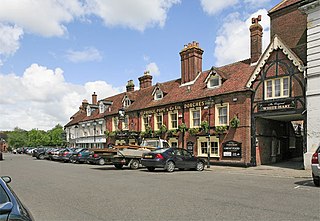
Ringwood is a market town in south-west Hampshire, England, on the River Avon close to the New Forest, northeast of Bournemouth and southwest of Southampton. It was founded by the Anglo-Saxons, and has held a weekly market since the Middle Ages.

Sutton Waldron is a village and civil parish in north Dorset, England, situated on the A350 road between Iwerne Minster and Fontmell Magna, in the Blackmore Vale under the scarp of Cranborne Chase, 8 miles north of Blandford Forum and 5 miles south of Shaftesbury. In the 2011 census the parish had 93 dwellings, 87 households and a population of 200.

Rockbourne is a village and civil parish in the English county of Hampshire, close to Fordingbridge.
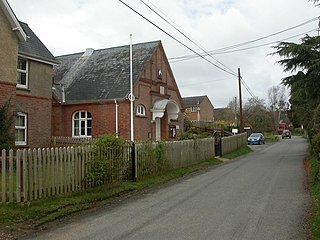
Whitsbury is a village and civil parish in Hampshire, England, close to Fordingbridge. Whitsbury is a part of a group of villages on the edge of the Cranborne Chase and West Wiltshire Downs Area of Outstanding Natural Beauty.

Breamore is a village and civil parish near Fordingbridge in Hampshire, England. The parish includes a notable Elizabethan country house, Breamore House, built with an E-shaped ground plan. The Church of England parish church of Saint Mary has an Anglo-Saxon rood.

Damerham is a rural village and civil parish in the New Forest district of Hampshire, England, near Fordingbridge. The area has notable Neolithic and Bronze Age barrows. It was the site of an Anglo-Saxon religious community, mentioned in the will of Alfred the Great. By the time of Domesday Book (1086), Damerham was a major settlement in the possession of Glastonbury Abbey. The village has a riverside mill and a Norman church.

Martin is a village and civil parish in the New Forest district of Hampshire, England. The nearest town, Fordingbridge, is 7 miles (11 km) to the south-east, and the cathedral city of Salisbury is 12 miles (19 km) to the north-east.

Bramshaw is a small village and civil parish in Hampshire, England. It lies just inside the New Forest. The name Bramshaw means Bramble Wood.

Hale is a small village and civil parish in Hampshire, England. It lies on the border of the New Forest, overlooking the valley of the River Avon. The village is about 3.5 miles (5.6 km) north-east of the town of Fordingbridge, and about 8 miles (13 km) south of the city of Salisbury. Within the parish stands Hale House, a large 18th-century mansion which was the country house of architect Thomas Archer, who also rebuilt Hale church in 1717.

Baron Waleran, of Uffculme in the County of Devon, was a title in the Peerage of the United Kingdom. It was created on 23 December 1905 for the Conservative politician Sir William Walrond, 2nd Baronet, of Bradfield House, Uffculme. The name of the barony, with its spelling being a variant of the family name, appears to have been chosen to suggest a possible ancestry from Waleran the Huntsman, feudal baron of West Dean, Wiltshire, at the time of the Domesday Book of 1086, which was held by the Waleran family until the death of Walter Walerand in 1200/1 leaving three daughters his co-heiresses. His elevation to the peerage did not cause a by-election due to the upcoming general election, where his son, William, succeeded him as the Member of Parliament for Tiverton. The Walrond Baronetcy, of Bradfield and of Newcourt, both in the County of Devon, was created in the Baronetage of the United Kingdom on 24 February 1876 for the first Baron's father, John Walrond, who also represented Tiverton in Parliament. The title was named after the family's manor of Bradfield, Uffculme, Devon, held by them since the 13th century. The baronetcy and barony became extinct on the death of the first Baron's grandson, the second Baron, on 4 April 1966.

Ellingham is a small village and former civil parish, now in the parish of Ellingham, Harbridge and Ibsley, in the New Forest district, in the county of Hampshire, England. It is near Ringwood, west of the New Forest National Park. Ellingham is most famous for the story of Alice Lisle, who was executed by the infamous Judge Jeffreys in 1685, on the charge of harbouring fugitives after the defeat of the Monmouth Rebellion. In 1961 the parish had a population of 595.
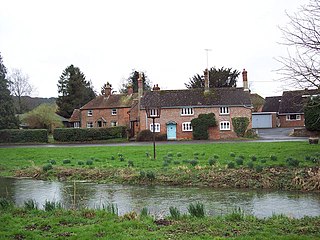
West Dean is a village and civil parish in southeast Wiltshire, England; the Wiltshire/Hampshire border runs through the eastern part of the village. The village is on the River Dun, about 7 miles (11 km) east of Salisbury and the same distance northwest of Romsey.
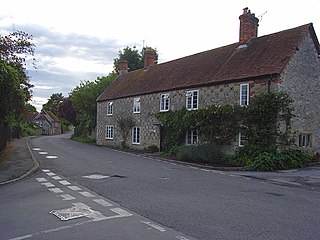
Steeple Langford is a village and civil parish in the English county of Wiltshire, 6 miles (10 km) northwest of Wilton. It has also been called Great Langford or Langford Magna. The village lies on the north bank of the River Wylye, and is bypassed to the north by the A36 Warminster-Salisbury trunk road which follows the river valley.

Crow is a small village situated in the New Forest National Park in Hampshire, England. Its nearest town is Ringwood, which lies approximately 1 mile (1.6 km) north-west from the village.

Ashley is a village located in the southwest of Hampshire, England. It lies on the eastern outskirts of New Milton in the New Forest district, and is two miles (3 km) inland from the sea. Its history dates back to the Domesday book of 1086, when two estates were recorded. In the 15th century much of Ashley merged with a neighbouring manor, and the estate became known as Ashley Arnewood. As a village, Ashley began to develop in the 19th century when a church and a school were built. Most of the current village was built in the 20th century, and today Ashley is effectively a suburb of New Milton.
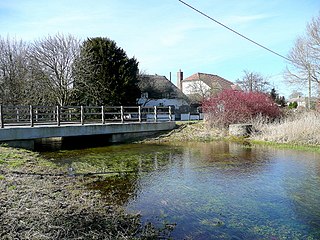
Newton Tony is a rural English village and civil parish in the county of Wiltshire, close to the border with Hampshire. Situated in the Bourne Valley, Newton Tony is about 9 miles (14 km) north-east of its post town, Salisbury. Wilbury House, a Grade I listed 17th-century mansion, stands in parkland in the north of the parish.
John of Monmouth was an Anglo-Norman feudal lord of Breton ancestry, who was lord of Monmouth between 1190 and 1248. He was a favourite of both King John and his son, Henry III, and one of the most powerful royal allies in the Welsh Marches.

Avon Tyrrell is an historic manor within the parish of Sopley, Hampshire. It is situated within the New Forest, near Christchurch. The present manor house was built in 1891 by John Manners-Sutton, 3rd Baron Manners (1852–1927).

Washfield is a village, parish and former manor in Devon, England, situated about 2 miles north-west of Tiverton. The parish church is dedicated to St Mary the Virgin. It was within the jurisdiction of the historic West Budleigh Hundred.
The Manor of Heanton Punchardon was a manor in the parish of Heanton Punchardon, Devon, England.
References
- ↑ Described as such at head of Domesday Book, chapter xxxvii, Wiltshire:Terra(e) Waleran Venatoris ("Lands of Waleran the Hunter") and at head of chapter xlv, Domesday Book, Hampshire: Terra(e) Waleran Venat(oris) ; Venatoris is the genitive case of venator (nominative case)
- ↑ Hoare, Modern Wiltshire, 'Hundred of Cawden,' iii. 24